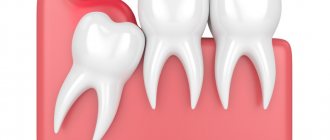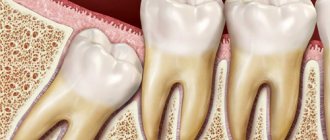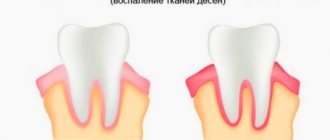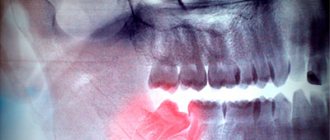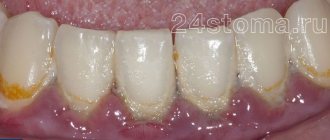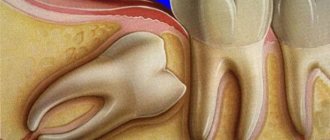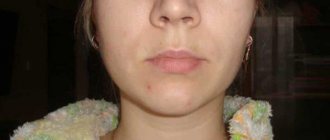In a completely healthy person, the base and roots of the teeth are covered with durable soft gum tissue. Thanks to it, they are held in place and are saturated with nutrients. But sometimes during brushing or examination, a phenomenon such as raised gums is noticeable. This pathology is called “exposure” by dentists. If timely treatment is not started, complications such as periodontal disease, bleeding and tooth loss are possible.
The gums have risen on the teeth
Why does the gum rise above the tooth?
About 10% of patients turn to dentists with such a defect. Their gums rise noticeably above the tooth and voluminous periodontal pockets form. Outwardly, it looks very ugly, as a result of which a person is obliged to hide his smile from others. In addition, he experiences pain when eating cold or hot food.
The following reasons can influence the development of the pathological process:
- Impaired metabolism and hormonal imbalance (most often people with diabetes, pregnant women and women during menopause turn to the dentist with a similar problem);
- Lack of minerals and amino acids. The reason is an unbalanced diet and strict diets that require a strict diet.
- Lack of proper oral care. If you brush your teeth incorrectly, plaque appears on the enamel, which over time hardens and turns into stone.
- Congenital malocclusion pathologies or incorrect positioning of the incisors.
According to statistics, most often the gums rise in people in adulthood and are practically not diagnosed in young children. The risk group includes people who often drink strong drinks or smoke cigarettes. Frequent damage from using a hard toothbrush and untreated infections also soften periodontal tissue, leading to mobility and bleeding.
Raising the gums above the crown in older people is a natural process. Soft tissues age, become thin and less flexible. They are unable to hold teeth and dentures in ideal position. As a result, this leads to deformation and fracture of the bridge.
Symptoms
A healthy tooth has a beautiful rounded gum margin. But if the gum has risen above the tooth, not only the crown is visible, but also the hidden part - the neck. It has a yellowish tint, significantly different from the color of enamel. Therefore, raised gums are a fairly noticeable defect, especially when they occur in the smile area.
You can understand that the gums have risen by the following signs:
- Painful sensations caused by brushing teeth and prolonged exposure to the cold.
- Severe discomfort that occurs if you eat hot, spicy, sour, or cold foods.
- The appearance of traces of blood on solid foods (apples, carrots) or a toothbrush.
- Visual change in tooth color.
- Edema, inflamed, swollen gums.
- Increased enamel fragility, carious lesions, chips, cracks.
- Visual elongation of the tooth caused by displacement of the gingival margin. Against this background, the spaces between the teeth increase.
- The appearance of a periodontal pocket due to the inflammatory process. There is an accumulation of pus in it.
- Bad breath.
- Loose teeth, increasing the risk of tooth loss.
Causes of the disease
It is impossible to restore the gum without determining the exact cause of its receding, so it is not even worth starting treatment without this. The following diseases can affect the development of periodontal pathology:
- periodontal disease;
- gingivitis in severe stage;
- periodontitis.
In addition to soft tissue diseases, the next factor is poor oral hygiene, as a result of which deposits accumulate in the periodontal pocket. This creates favorable conditions for the proliferation of pathogenic microflora. As a result, the depressions expand, and toxins released by bacteria corrode the tissue around them.
Treatment Options for Gum Recession
After finding out the main reason that caused such an unpleasant phenomenon, treatment can begin. When treating gum recession, the primary goal is to preserve the tooth and prevent future weakening of the gum tissue.
Receding gums are always a consequence of some disease or pathological process. As for treating the recession symptom, modern medicine can offer several ways to eliminate such an unpleasant defect:
- Professional oral hygiene against plaque and deposits . In this type of cleaning, you need to focus on deposits in the gum pockets. Regularly carrying out such a procedure under the supervision of a dentist is the best way to prevent gum peeling and many other dental diseases.
- Treatment using the Vector device . This device takes teeth cleaning to a new level; the advanced German Vector technology perfectly helps to cope with the removal of tartar and plaque. The device releases ultrasonic waves that are safe for the body, but prevent harmful infusion on deposits in the oral cavity.
- Gum curettage is a procedure that helps to effectively get rid of deposits and plaque, and also, if necessary, normalize the condition of bone tissue. There are 2 options for carrying out this procedure. The first option, “closed curettage,” is recommended for patients whose periodontal pockets are no more than 5 mm deep and inflammatory processes have not yet penetrated deep into the bone. The second option is “open curettage” for pockets with a depth of more than 5 mm. In such a situation, the doctor makes a small incision in the gum, thereby peeling off a small section of it to gain access to the bone tissue and tooth root. Then the doctor carries out an antiseptic treatment; if there is bone atrophy, bone chips are planted to restore its normal state.
- Plasmolifting. This type of lifting involves the direct introduction of special autoplasma into problem areas, which is previously isolated from the patient’s blood. Before the procedure, you need to donate about 15 ml of blood, from which the doctor will separate plasma. Such plasma contains an increased number of platelets and protein. Then this liquid enters the gums through an injection and promotes its restoration.
- Vestibullasty of the gums. This method involves a surgical intervention during which a piece of healthy gum is transplanted to the site of the damaged one. After such treatment, long-term drug therapy is prescribed.
- Treatment with vitamins. In the early stages of gum recession, gum recession can be treated by taking a special set of vitamins and professional cleaning. In such a situation, the patient is usually prescribed vitamins A, D, B9, C. It is their lack that weakens the gums.
In the case when the gum recession is too advanced and the tooth is already clearly loose, it is necessary to undergo a splinting procedure (combining the moving parts of a row into a new group and fixing it in the desired position). For fixation, a thin aramid thread is usually used, which is attached to the back of the row, or a prosthesis with claw-shaped branches is installed under each loose tooth.
It is worth noting that sometimes, when the gums have almost exposed the root, the tooth is very loose and is in poor condition, the best solution is to remove it. In the future, an implant can be installed in its place, which will be indistinguishable from a real tooth. Such an implant is the only option to preserve a beautiful smile and jaw functionality.
How the disease develops
In a healthy person, the tooth is located in the gum. Only the upper part, the crown, is raised outward. It is protected by a layer of enamel from temperature changes, harmful bacteria and other damage. When the neck or root is exposed, the patient feels pain every time he touches the gum or eats cold or hot food. The reason for such symptoms is the absence of a protective layer.
Healthy periodontium versus unhealthy periodontium
When the gums rise above the upper tooth, causing its base to become visible, this is a sign of periodontal disease. This unpleasant disease has increasing symptoms and develops in several stages:
- First stage . 1/3 of the gums are lifted, with no pain or discomfort.
- Second . There is a strong detection of the base of the teeth, bleeding during brushing and the presence of a putrid odor.
- Third . Periodontitis tissues become soft and are unable to hold molars and incisors in the correct position. Patients feel severe discomfort and pain, which prevent them from eating fully or drinking cool drinks.
If the gums rise above the crown as a result of periodontitis, there is a risk of infection spreading to the exposed areas. Suppuration occurs and fistulas form. Pathogenic microflora leads to inflammation in the roots, which threatens tooth extraction.
Symptoms and forms of the disease
Today, when diagnosing the severity of the disease, the Miller classification is used, which involves 4 stages of gum recession.
- Visually, gum loss is hardly noticeable (or completely unnoticeable) and appears only in the area of contact between the tooth and gum.
- The defect appears slightly in the area of contact between the gum and the neck of the tooth (the level of the attached gum decreases by 1-2 mm). The gums between the teeth remain at the same level.
- The gums recede by 3 mm or more. The necks of the teeth are slightly exposed, but the bone level does not decrease. At this stage, the gums often recede and bleed.
- The most severe stage, when the gums recede by 5 mm or more, the roots of the teeth become visible. Mobility of the teeth is observed, which at this stage of the pathology is often generalized and involves several teeth.
At advanced stages, pathology can be noticed visually, especially when the gums on the front teeth recede. If the pathology is at the beginning of its development, a number of additional symptoms help to detect it.
- Inflammatory process, bleeding.
- Formation of periodontal pockets.
- The sensitivity of the enamel has increased.
- The presence of a thick layer of dental plaque.
- Unhealthy whitish tint of gums.
Only a doctor can make an accurate diagnosis (using modern technologies), so if you have at least one symptom, you should not postpone your visit to the clinic. Of course, everyone is interested in the question of what to do if the gums on a tooth have receded and what treatment should be chosen. There are two directions: therapeutic and surgical. The choice depends on the severity of the pathology and the underlying disease that led to soft tissue atrophy.
Treatment of pathology
Lateral flap
Using this method, it is possible to lift the gums. But it is rarely used due to the fact that healthy tissue has to be displaced onto damaged areas. This defect affects almost the entire jaw, so it is difficult to apply a lateral flap.
The positive quality of this method is the instant result. If all preventive standards are followed, the risk of relapse is minimized.
Surgery to correct gum recession
Collagen membrane
It is placed on the cortical plate of the alveolar process for tissue regeneration. When its functions are restored, it will be deleted. Although some dentists use absorbable materials that dissolve on their own after a certain period of time. But they just cost more. Due to the membrane, approximately 80% of tissues are restored.
Rinse preparations
You can purchase ready-made mouth rinses at the pharmacy. The most effective remain:
- Chlorophyllipt;
- Furacilin;
- Miramistin;
- Chlorhexidine;
- Forest balm;
- Malavit;
- Rotokan.
Before using any of the above medications, read the instructions, as some medications need to be diluted with water.
Surgery
If drug therapy does not produce the desired results, then the gums at the bottom of the tooth can be lowered using surgical intervention. This will restore the level of the gums, covering the exposed roots of the tooth. For these purposes, soft tissues are transplanted from the upper palate or moved from nearby areas, provided they are of sufficient volume.
If tissue is removed from the upper palate during the operation, scars may form at the site where it is planted. This will reduce aesthetics, so it is better to use the option of moving the fabric from a nearby area.
Types of marginal periodontal elevation
Raising gums occurs:
- Local. The gingival margin rises over only one tooth.
- Generalized. The necks are exposed throughout the entire jaw or a significant area of it.
- Traumatic. The cause is mechanical damage (impact, bruise, cut).
- Symptomatic. The reason for the elevation of the marginal periodontium is the accumulated bacteria and the developed inflammatory process.
- Physiological. The reason is the natural aging of the body. This type of gum elevation is not associated with inflammation.
Folk remedies
Tincture of calamus root and propolis
Required components:
- propolis – 10 g;
- alcohol – 0.5 l.
Combine the presented components and place the container with the tincture in a dark place. Keep her there for 14 days. Now grind the calamus root and pour in 0.5 liters of spit. Also leave for 2 weeks. At the end of the specified time, combine an equal amount of tincture. Use the resulting composition to rinse the mouth 3 times a day.
Propolis tincture
Herbal decoctions
The following plants are used for these purposes:
- chamomile;
- yarrow;
- mint;
- Melissa.
These herbs were not chosen by chance, as they have an anti-inflammatory effect. Take 20 g of finely chopped plant and pour 200 ml of boiling water. Simmer for 15-20 minutes, cool, filter and use for rinsing after each meal. The use of herbal infusions has a positive effect on the condition of tissues.
You can get a positive result only if you use the decoction on a regular basis.
Beetroot compress
Peel the fresh root vegetable and grate it. Add 2 drops of sage essential oil. Wrap the resulting pulp in a bandage and apply to the gums for 20 minutes. Carry out such events 2 times a day. You can use boiled beets, but then cut off a plate from it and grease it with oil, and only then apply it to the gums.
Chamomile infusion
Homemade ointment
Required components:
- olive oil – 20 ml;
- rose oil – 4 drops.
Rub the resulting composition into the gums 3 times a day for a month.
Infusion of rose petals
Pour 10 g of raw material into 200 ml of boiling water. Leave for 6 hours in a thermos. Filter and use as a mouth rinse 3 times a day.
Prevention
You can prevent receding gums by following the following preventive measures:
- Rinse your mouth regularly to prevent bacterial plaque and tartar from accumulating along the gum line.
- Visit the dentist’s office every six months for a preventive examination, timely dental treatment and prosthetics.
- Use flux thread correctly to prevent injury to periodontal tissues;
- Maintain proper nutrition, including as many vegetables and fruits as possible in your diet.
- Use high-quality oral hygiene products.
- Eliminate bad habits - smoking, drinking strong drinks.
Receding gums are a common phenomenon that can be successfully treated if you seek help from a specialist in time. Timely detection of recession will allow you to get rid of it using conservative methods without resorting to surgery.

